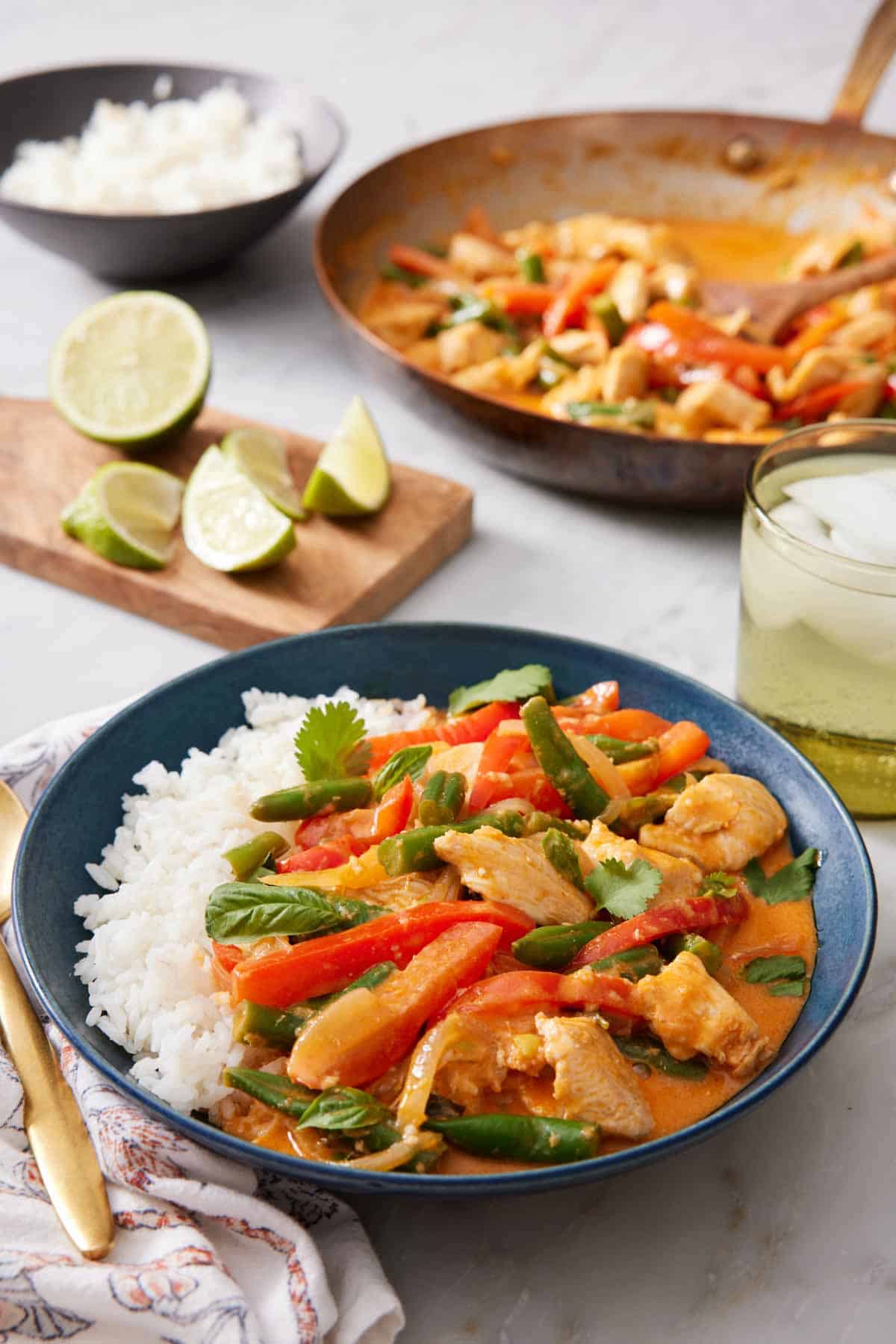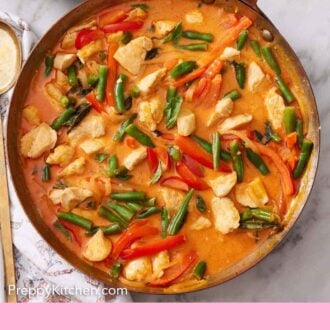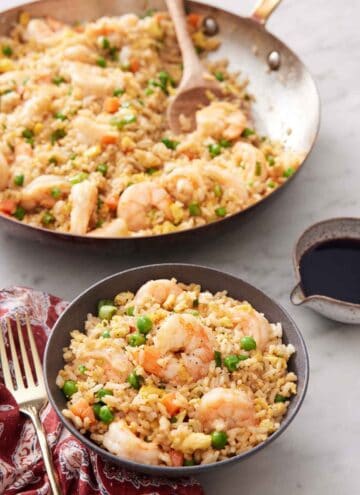Thai Red Chicken Curry with vegetables in a creamy coconut sauce is brimming with bold flavor! It’s the perfect meal for busy weeknights because it requires very little prep and is cooked on the stove for just 15 minutes! The depth of flavor from red curry paste, fresh ginger, garlic, and fish sauce is hard to beat.
There’s a lot of variation in how spicy store-bought Thai red curry can be, so start with a small amount of paste if you haven’t cooked with it before. My recipe is subtly spicy with the addition of creamy coconut milk. Plus, you can customize the dish with a variety of different vegetables! For more 30-minute meals, try my lettuce wraps, curried chicken salad, and easy chicken curry recipes.
Ingredients for Thai Red Curry

Chicken — boneless chicken thighs or chicken breast work well. I used thighs in this Thai curry recipe because they turn out more tender and don’t dry out as easily as chicken breast.
Aromatics — onion, ginger, and garlic add plenty of flavor to jazz up store-bought red curry paste.
Red curry paste — I use store-bought red curry paste for convenience, but you can certainly use a homemade red curry paste if you have one you love. Typically, canned curry paste can be found in the international food section of your grocery store.
Coconut milk — full-fat coconut milk from a can will give you the creamiest red curry.
Fish sauce — fish sauce adds umami for deeper flavor to the red curry sauce but will not make the sauce taste fishy.
Sugar — light brown sugar or palm sugar work well to add just a hint of sweetness to enhance the flavor of the spices.
Vegetables — chopped green beans and sliced red bell peppers add texture and freshness to this creamy dish. But you can add so many different types to suit your preference.
Basil — Thai basil leaves are a delicious finishing touch, but if you can’t find it, a sweet basil will work. You can usually find Thai basil at Asian markets or Asian grocery stores if your local supermarket doesn’t stock it.
Lime juice — fresh lime juice brightens the flavors in the soup and balances the richness.
How To Make Thai Red Curry

1. Brown the chicken in a large skillet, then remove it with a slotted spoon and set aside in a bowl. Note that it will not be completely cooked at this stage, but that’s fine! It will finish cooking in the sauce later on.
2. Add the onion, garlic, and ginger and cook over medium-high heat for 1 minute.

3. Stir in the curry paste and stir for 1 minute. You should be getting some mouth-watering aromas at this point.
4. Pour in the coconut milk and fish sauce.

5. Add light brown sugar. Bring the mixture to a simmer over medium heat.
6. Add the browned chicken back to the skillet.

7. Drop in the chopped green beans and sliced bell pepper. Simmer for about 8 minutes, until the chicken is cooked through and the vegetables are just tender.
8. Remove from the heat and add the finishing touches: fresh Thai basil leaves and lime juice. Serve immediately over rice.

Using Store-Bought Red Curry Paste
A jar of curry paste is such a convenient pantry item to keep on hand, but each brand of curry paste can vary by flavor and heat level. It’s worth trying a few different kinds to find the brand you like best!
If you have a curry paste without as much flavor as you’d like, you can fix it up by sprinkling garlic powder, ginger powder, salt, and smoked paprika into the sauce to taste. You can also boost the flavor with a little bit of bouillon paste or cube.
Recipe Variations
I love the flavors so many Thai food dishes have to offer and that they can be incredibly versatile with ingredients. Here are some easy ways to adapt this recipe to your preference or to use what you already have on hand:
- Use a variety of your favorite vegetables or any that you want to use up to clean out the fridge or freezer. Broccoli florets, sliced mushrooms, sliced zucchini, frozen peas, baby corn, bamboo shoots, and peeled and diced eggplant would all be delicious additions to this red Thai curry recipe.
- Swap out the protein. I love using chicken for this recipe, but you can use thinly sliced beef or pork instead. Or, go vegetarian by stirring in extra-firm tofu cut into 1-inch cubes.

How to Serve
Serve Thai red curry with chicken over fluffy jasmine rice or fragrant coconut rice for a satisfying, comforting dinner. I like sprinkling a little chopped cilantro or thai basil on top for more fresh flavor.
Storage Tips
Once the Thai red curry has cooled completely, transfer it to an airtight container and refrigerate for up to 5 days. Reheat it gently over medium heat in a skillet.
Pro Tips for Making this Recipe
- Use full-fat coconut milk. Lite coconut milk will not give you the same creamy sauce.
- Don’t boil the coconut milk. Make sure to simmer and not boil the coconut milk at a high temperature, or it may become grainy and curdle.
- Don’t overcook the vegetables. The veggies should be tender but not mushy, with a bit of bite.
- Adjust the seasonings to taste. Depending on your curry paste, add additional seasonings and salt to the curry sauce to suit your taste.

Frequently Asked Questions
The rich curry sauce is made of onions, ginger, garlic, Thai red curry paste, fish sauce, coconut milk, and light brown sugar. The coconut milk makes the sauce delightfully creamy and nutty in flavor.
Heat levels of store-bought Thai red curry paste can vary — the more red chiles the brand adds to the mixture, the hotter the paste will be. Some brand label their curry as “hot” or “spicy” to indicate if they have extra heat. Once combined with coconut milk, I’ve found that 3 tablespoons of curry paste gives me a very flavorful dish that isn’t very spicy.
If you like your curries extra spicy, chop up some bird’s eye or Thai chilis and toss them in with the aromatics. Or simply let each person sprinkle red pepper flakes, cayenne pepper, or hot sauce over their individual servings so everyone can control the spice level.
For a red curry sauce, yes. But you can make this recipe with other types of Thai curry pastes. Green curry paste, yellow curry paste, and panang curry paste are all delicious in this recipe.
Coconut milk will curdle (or break) if allowed to boil and get too hot. Keep the sauce at a gentle simmer. If the sauce does curdle, it won’t affect the taste. The sauce may feel a bit less smooth and creamy, but the flavor will still be delicious!
If you’ve tried this Thai red curry recipe, then don’t forget to rate it and let me know how you got on in the comments below. I love hearing from you!

Thai Red Curry Recipe
Ingredients
- 2 tablespoons vegetable oil
- 1 pound boneless skinless chicken breast or thighs cut into chunks (450g)
- 1 small onion sliced (142g)
- 1 tablespoon minced fresh ginger
- 4 garlic cloves minced
- 3 tablespoons Thai red curry paste
- 1 (13.6-ounce/403ml) can unsweetened coconut milk
- 1 tablespoon fish sauce
- 2 teaspoons light brown sugar
- 6 ounces green beans chopped (169g)
- 1 red bell pepper seeded and sliced (205g)
- ½ cup Thai basil leaves
- 1 tablespoon lime juice
- Cilantro for serving
Instructions
- Heat the oil in a large skillet over high heat. Add chicken and cook, stirring occasionally, until browned on all sides, about 3 minutes. Using a slotted spoon, remove the chicken and set aside in a bowl.
- Reduce the heat to medium-high and add the onion, garlic, and ginger. Cook, stirring constantly, for 1 minute. Stir in the curry paste and stir for 1 minute. Stir in the coconut milk, fish sauce, and brown sugar. Bring to a simmer over medium heat. (Do not let the coconut milk come to a hard boil, or it can curdle.)
- Once simmering, return the chicken to the skillet and add the green beans and bell pepper slices. Continue simmering until the chicken is cooked through and the vegetables are just tender, about 8 minutes.
- Remove from the heat and stir in basil leaves and lime juice. Serve immediately over rice with chopped cilantro or more basil leaves.
Notes
- Use full-fat coconut milk. Lite coconut milk will not give you the same creamy sauce.
- Don’t boil the coconut milk. Make sure to simmer and not boil the coconut milk at a high temperature, or it may become grainy and curdle.
- Don’t overcook the vegetables. The veggies should be tender but not mushy, with a bit of bite.
- Adjust the seasonings to taste. Depending on your curry paste, add additional seasonings and salt to the curry sauce to suit your taste.














